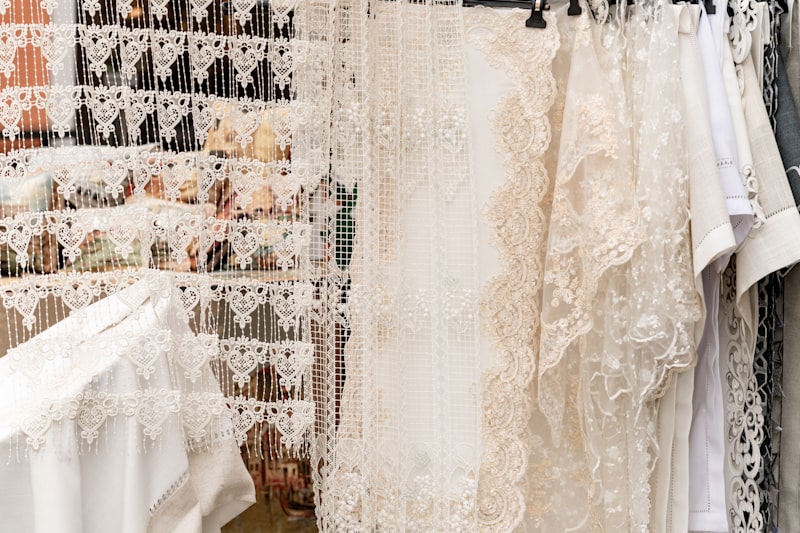The Role of Color in Fabric Choices for Brides
The Role of Color in Fabric Choices for Brides
Understanding the Importance of Color in Bridal Fabrics
Choosing the perfect wedding dress is one of the most significant decisions for brides-to-be. Among various elements that contribute to a stunning wedding gown, color plays a pivotal role. This article will explore how color influences fabric choices and overall bridal aesthetics, guiding brides in making informed decisions for their special day.
The Psychology of Color in Weddings
Color is not just an aesthetic choice; it has profound psychological implications. Different colors evoke distinct emotions and set the tone for the wedding. For example, white symbolizes purity and simplicity, making it a traditional choice for many brides. In contrast, red is often associated with passion and love, commonly chosen in cultures where this color holds significant meaning, such as in Chinese weddings.
Popular Colors and Their Associations
| Color | Symbolism |
| White | Purity, Innocence |
| Red | Love, Passion |
| Blue | Calmness, Peace |
| Pink | Affection, Romance |
| Green | New Beginnings, Growth |
| Gold | Wealth, Prosperity |
Choosing Fabrics Based on Color
Once brides have chosen a color that resonates with them, the next step is selecting the right fabric. Different fabrics interact with color in unique ways, influencing how the color appears and feels. Here are some popular fabric options for brides:
Satin
Satin is a luxurious fabric that enhances the depth of color, making it an ideal choice for bold hues. The smooth surface reflects light beautifully, creating an elegant and sophisticated look. Many brides opt for satin in colors like deep burgundy or royal blue, which can add a touch of drama to their wedding attire.
Lace
Lace is a timeless option that adds texture and intricacy, often layering over other fabrics. When combined with soft colors like blush or ivory, lace can create a romantic and ethereal vibe. The delicate patterns of lace can also influence how the color is perceived, giving it an enchanting quality.
Tulle
Tulle is a lightweight and airy fabric that’s perfect for achieving a dreamy aesthetic. Popular in lighter shades, tulle works wonderfully in wedding dresses with layered skirts, creating movement and softness. Many brides choose pastels like lavender or mint green in tulle for a whimsical effect.

Seasonal Color Trends
The season in which the wedding takes place can significantly influence color choices. For instance, brighter colors are often favored in spring and summer weddings, while deeper, richer tones may be more appropriate for fall and winter. Here’s a brief overview of seasonal color trends:
| Season | Popular Colors |
| Spring | Pale Pink, Lavender, Light Blue |
| Summer | Coral, Bright Yellow, Teal |
| Fall | Burgundy, Forest Green, Mustard Yellow |
| Winter | Ivory, Deep Red, Navy Blue |
Current Trends in Bridal Fashion
The bridal industry continues to evolve, prompting brides to stay informed about the latest trends. In recent years, we’ve seen an increase in brides opting for colored wedding dresses rather than traditional white. This trend embraces individuality and allows brides to express their personal style. Some popular trends include:
Colored Gowns
More brides are breaking away from tradition and choosing colored gowns that reflect their personalities. Popular choices include soft pastels, jewel tones, and even unconventional colors like black or silver. These gowns allow brides to stand out and make a bold statement.
Mix and Match
An increasing number of brides are mixing and matching colors and fabrics for their bridal parties. Coordinating dresses in varying shades of the same color or incorporating different fabrics can add depth and interest to the overall aesthetic. This trend promotes cohesiveness while allowing individual expression.
Choosing the Right Color for Different Skin Tones
Another essential consideration for brides is how color complements their skin tone. Not all colors suit every complexion, so it’s crucial to choose shades that enhance natural beauty. Here are guidelines for selecting colors based on skin tones:
Cool Skin Tones
Brides with cool skin tones tend to look best in colors like blue, lavender, and emerald green. These shades create a harmonious look, enhancing the overall appearance.
Warm Skin Tones
Brides with warm skin tones can feel radiant in colors such as peach, coral, and gold. These colors bring out warmth in the skin and create a glowing effect.
Neutral Skin Tones
For those with neutral skin tones, colors like taupe, jade, and even bright shades can work wonderfully. Neutral tones offer flexibility and allow brides to experiment with various hues.
Final Thoughts and Recommendations
Color plays an invaluable role in the fabric choices for brides, affecting everything from the overall theme to the emotional impact of the wedding attire. It’s essential for brides to consider factors like personal style, seasonal trends, and how color interacts with fabric when making their selections.
By taking time to explore color psychology, seasonal palettes, and complementary shades based on skin tone, brides will make empowered fabric choices that reflect their individuality on their special day. Whether opting for a classic white gown or a vibrant colored dress, the right combination of color and fabric will ensure the bride feels beautiful and confident.
In summary, embrace the exciting world of color in bridal fashion and remember to follow the trends that resonate with your personal style. Happy planning!
